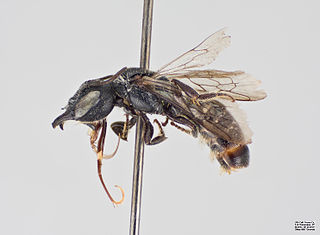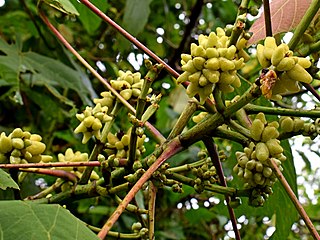
Tiliaceae is a family of flowering plants. It is not a part of the APG, APG II and APG III classifications, being sunk in Malvaceae mostly as the subfamilies Tilioideae, Brownlowioideae and Grewioideae, but has an extensive historical record of use.

Herpesviridae is a large family of DNA viruses that cause infections and certain diseases in animals, including humans. The members of this family are also known as herpesviruses. The family name is derived from the Greek word ἕρπειν, referring to spreading cutaneous lesions, usually involving blisters, seen in flares of herpes simplex 1, herpes simplex 2 and herpes zoster (shingles). In 1971, the International Committee on the Taxonomy of Viruses (ICTV) established Herpesvirus as a genus with 23 viruses among four groups. As of 2020, 115 species are recognized, all but one of which are in one of the three subfamilies. Herpesviruses can cause both latent and lytic infections.
Channa burmanica is a species of snakehead which is endemic to northern Burma. It is a very small species of snakehead included in the informal group of dwarf snakeheads. Its colouring closely resembles that of Channa gachua and Channa bleheri. It is very rarely found in pet shops. It is also considered to be a mouthbrooder species, though no successful breeding has yet occurred.

Olyra is a genus of catfishes of the family Bagridae. This genus occurs throughout South Asia and western Indochina, from India to western Thailand.
Burretiodendron is a genus of trees. Traditionally included in the family Tiliaceae, it is included in the expanded Malvaceae in the APG and most subsequent systematics. It contains some species formerly in the Pentace. Thus, ParapentaceGagnep. may be a synonym of Burretiodendron rather than Pentace.
Pentace acuta is a species of flowering plant in the family Malvaceae sensu lato or Tiliaceae. It is a tree endemic to Peninsular Malaysia.
Pentace microlepidota is a species of flowering plant in the family Malvaceae. It is a tree endemic to Peninsular Malaysia.
Pentace strychnoidea is a species of flowering plant in the family Malvaceae sensu lato or Tiliaceae. It is a tree endemic to Peninsular Malaysia.

Karenia is a genus that consists of unicellular, photosynthetic, planktonic organisms found in marine environments. The genus currently consists of 12 described species. They are best known for their dense toxic algal blooms and red tides that cause considerable ecological and economical damage; some Karenia species cause severe animal mortality. One species, Karenia brevis, is known to cause respiratory distress and neurotoxic shellfish poisoning (NSP) in humans.

Olyra burmanica is a species of longtail catfish endemic to Myanmar where it is found in Pegu Yomas. This species grows to 11 cm (4.3 in) in total length.
Buchonomyia is the only extant genus of the subfamily Buchonomyiinae of the non-biting midge family Chironomidae. There are three known extant species and one fossil species in the genus: Members of the genus are parasitic of psychomyiid caddisflies.
The Burmese stone loach is a species of ray-finned fish in the genus Balitora. It occurs in the Irrawaddy, Salween, and Tenasserim basins in Burma, China, and Thailand. Its maximum length is 10 cm (3.9 in) TL.

Protosmia is a genus of subgenus Chelostomopsis in the family Megachilidae. There are more than 30 described species in Protosmia.
Aoria is a genus of leaf beetles in the subfamily Eumolpinae. Members of the genus are distributed in East and Southeast Asia. Food plants are known for only a few species, all of which were recorded from Vitaceae.
Pseudaoria is a genus of leaf beetles in the subfamily Eumolpinae. It is distributed in East and Southeast Asia. The genus was first established by Martin Jacoby, in a volume of The Fauna of British India posthumously published in 1908, for two newly described species from Manipur and Burma. Pseudaoria is similar to the genus Aoria. In a review of the latter genus in 2012, L.N. Medvedev included Pseudaoria as a subgenus of it.

Macaranga triloba is a species of plant in the family Euphorbiaceae. It is native to the tropical forests of southeastern Asia. It is a pioneer species, colonising recently cleared or burnt areas of the forest.
Pentace laxiflora is a species of flowering plant in the family Malvaceae sensu lato or Tiliaceae. It is a tree endemic to Borneo. Its conservation status has been listed by the International Union for Conservation of Nature as being of least concern.

The Myanmar coastal rain forests is a tropical moist broadleaf forest ecoregion in Myanmar. The ecoregion occupies Myanmar's coastal lowlands along the Bay of Bengal and Andaman Sea.

Damrongia is a genus of flowering plants in the Gesneriad family, centered in Thailand and found in southern China, Southeast Asia, and Sumatra. Species were reassigned to it in 2016 in a revision of Loxocarpinae.
Corchoropsis is a genus of flowering plants belonging to the family Malvaceae. It contains three species native to eastern Asia, which range from Myanmar and Thailand through China to Korea and Japan. Two species, C. burmanica and C. sinensis, are shrubs or small trees, and C. crenata is an annual.









